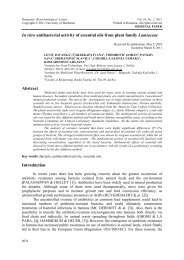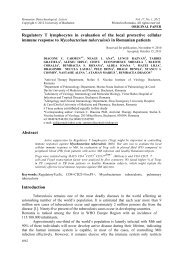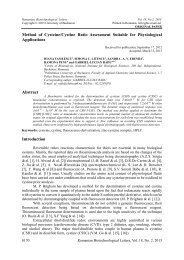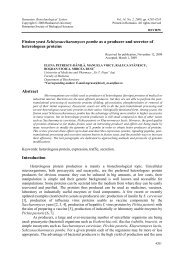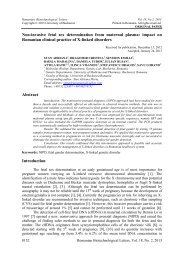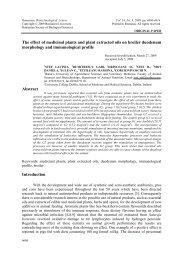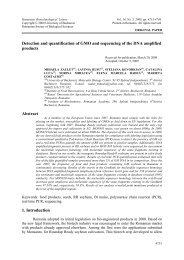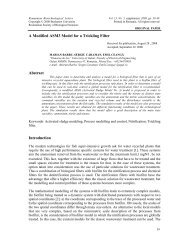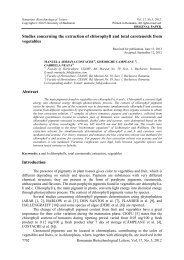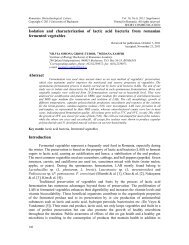(Pisum sativum L.) variety - Rombio.eu
(Pisum sativum L.) variety - Rombio.eu
(Pisum sativum L.) variety - Rombio.eu
You also want an ePaper? Increase the reach of your titles
YUMPU automatically turns print PDFs into web optimized ePapers that Google loves.
MANJU BALA, T.N.NAG, KAVITA MATHUR, MANMOHAN VYAS, ANITA SAINI,<br />
BALVIR TOMAR AND SANDEEP KUMAR<br />
[10]), plant defense and stress physiology, carbohydrate metabolism and packaging of storage<br />
proteins (ETZLER [11], KIJNE & al. [12], SHARON & LIS [13], SHUKLA & al. [14]).<br />
Lectins are also known to exhibit a wide <strong>variety</strong> of biological activities in animals (SONI &<br />
al. [15]). Lectins have been tested for their toxicity and may be useful as anticancer drugs<br />
(OPPENHEIMER & al. [16]) and anti HIV agent (NAEEM & al. [17]).<br />
Lectins from leguminous seeds are among the most extensively studied plant lectins.<br />
Lectins found in legume seeds constitute a family of related proteins sharing structural and<br />
amino acid sequence homologies (SHARON & LIS [18]). Typically, these lectins are<br />
glycoproteins consisting of subunits with molecular masses in a range of 25 to 35 KD<br />
arranged as dimers or tetramers. These are particularly abundant in legume seeds, accounting<br />
as much as 10 % of the total seed protein (ETZLER [11]). The seed lectins accumulate in<br />
protein storage vacuoles of cotyledons and are degraded during seed germination as well as<br />
maturation of the seedlings (PUSZTAI [10]). Pea seeds as well as seedling parts i.e. root,<br />
shoot etc. have already been reported to contain lectins (DIAZ & al. [1], VAN DRIESSCHE<br />
& al. [19], BAJAJ & SONI [20]). In general, vegetative lectins are present at much lower<br />
levels than those of seed and also have not been characterized as well. Although some<br />
vegetative lectins possess strong homologies with seed lectins, others display unusual<br />
carbohydrate- binding characteristics and an in-ability to agglutinate erythrocytes (PUSZTAI<br />
[10], ETZLER [11]).<br />
Plant tissue and cell cultures could be an alternative continuous source of lectins and<br />
could also be a useful and important tool to study their regulation and biosynthesis. Although<br />
in vitro production of lectin from different sources have been reported (BHATTACHARYA<br />
& al. [5], D’SILVA & al. [6], D’SILVA & PODDER [7], GUPTA & SRIVASTAVA [8],<br />
SILVA & al. [9]) and callus using different explants has been raised using different hormonal<br />
combinations in grass pea (Lathyrus sativus L) (OCHATT & al. [21]) and pea (<strong>Pisum</strong> <strong>sativum</strong><br />
L.) (SHARMA & KAUSHAL [22], SIDHU & DAVIES [23]). But there are a few/ no reports<br />
regarding the studies on lectins in callus cultures of pea plants. So present study has been<br />
undertaken to establish tissue cultures of pea (<strong>Pisum</strong> <strong>sativum</strong> L.) <strong>variety</strong> (AP-1) and screening<br />
of these for presence of lectins along with seeds .The interest in the present study is based on<br />
the fact that lectins have been employed in various biotechnology applications and callus<br />
cultures could represent a convenient system to obtain and purify considerable amounts of<br />
lectins.<br />
Material and Methods<br />
Seed sample:<br />
The seeds of pea (<strong>Pisum</strong> <strong>sativum</strong> L.) <strong>variety</strong> AP-1 were obtained from Agriculture<br />
Research Station, Beechwal, Rajasthan Agriculture University, Bikaner.<br />
Rabbit blood:<br />
Rabbit Blood used for making RBC suspension required for haemagglutination study<br />
was procured from National Research Centre on Camel (NRCC), Bikaner, Rajasthan, India.<br />
Explant preparation<br />
Seeds were first washed thoroughly under flowing tap water, followed by several<br />
washings with solution of liquid detergent and sterile distilled water. Seeds were then treated<br />
with 0.1 % HgCl 2 for 2 to 3 minutes followed by treatment with bevistin and then rinsed 3 to<br />
4 times with sterile distilled water. Paper bridges were prepared with filter paper strips taken<br />
in test tubes with their ends soaked in distilled water and autoclaved for 15 to 20 minutes.<br />
Surface sterilized seeds were aseptically inoculated on the paper bridges. From 8-10 days old<br />
5782 Romanian Biotechnological Letters, Vol. 15, No. 6, 2010



